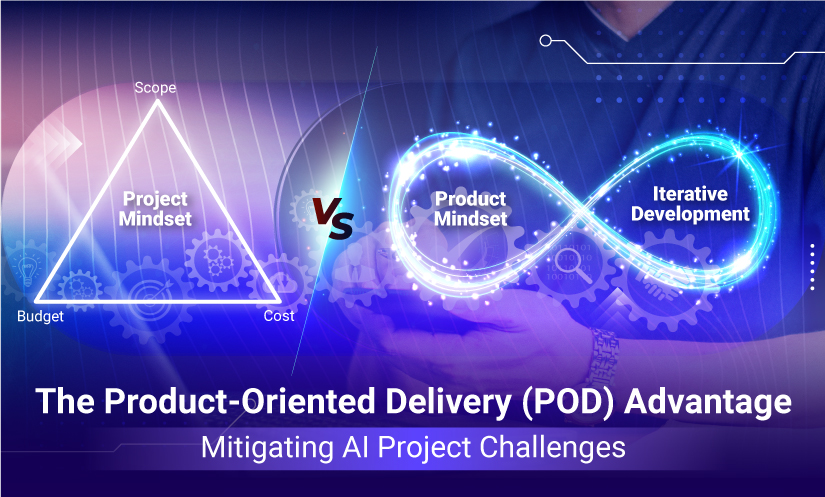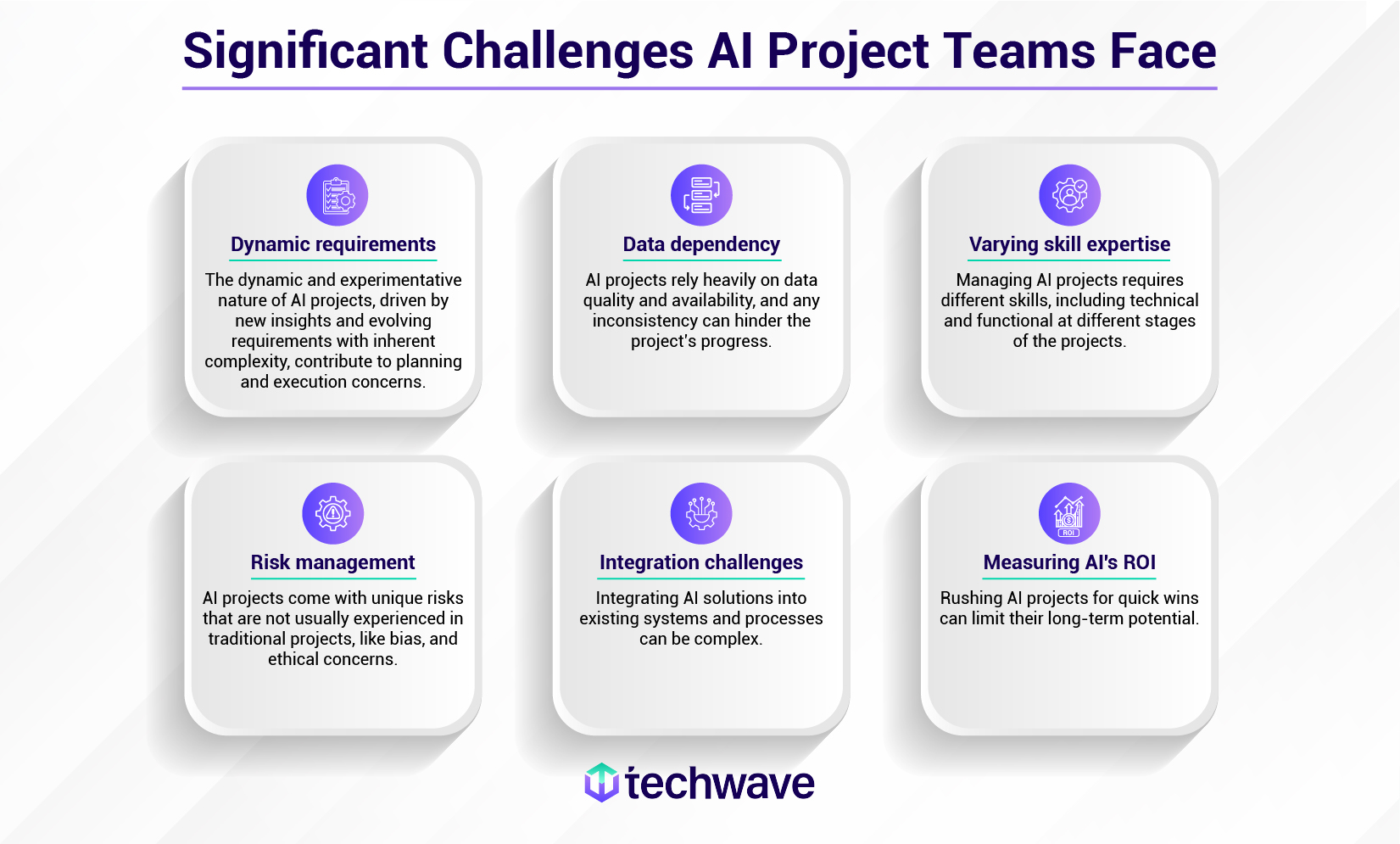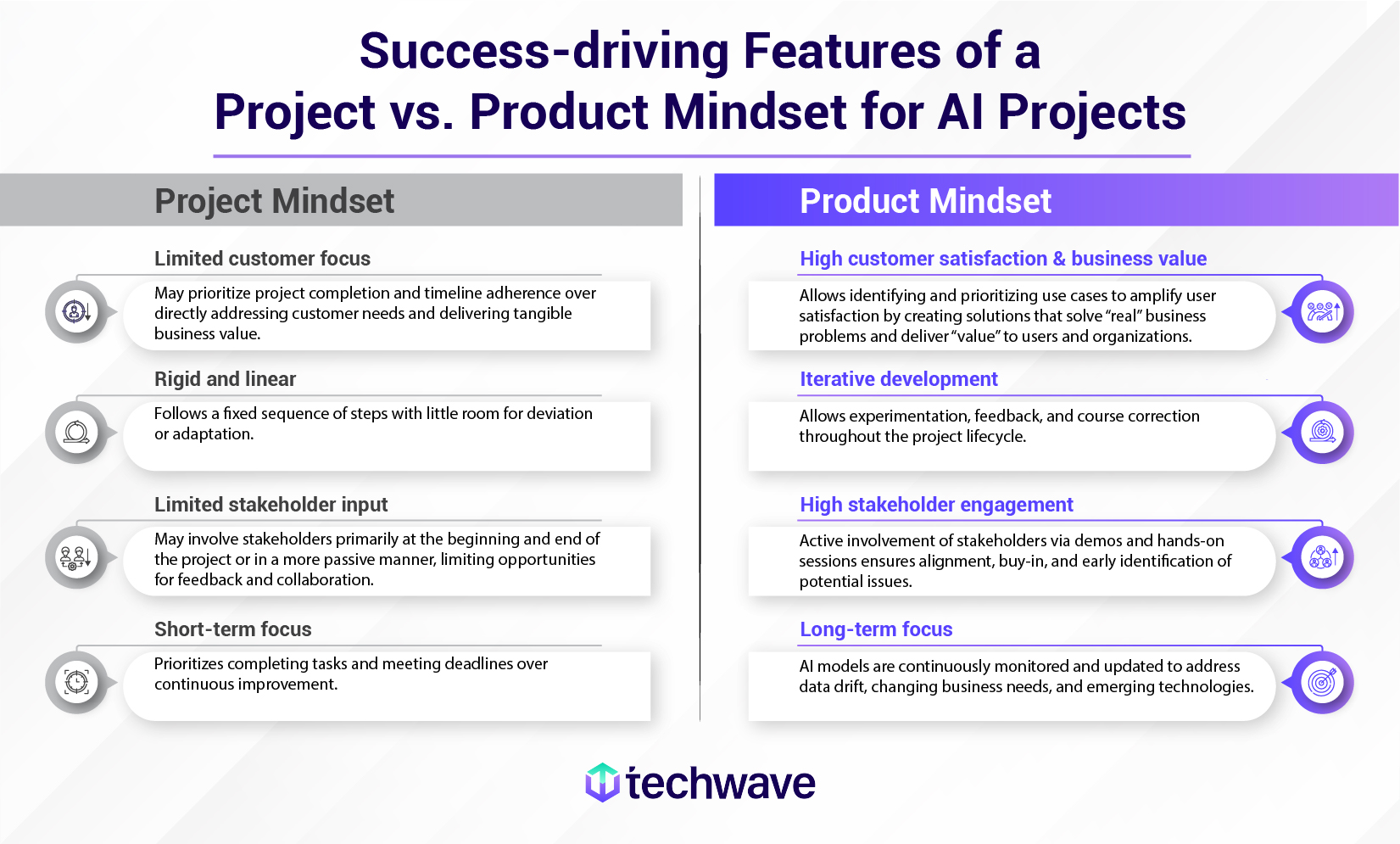
You’ve jumped into Artificial Intelligence (AI) with big ambitions: smarter decisions, better operations, and new revenue streams. But if your AI projects feel like they’re stalling—over budget, under-delivering, or moving slowly—you’re not alone. The problem often lies in how the AI project is managed. Many organizations are stuck in a project-oriented mindset, thinking what worked for other projects will work again. But AI is different. It demands a shift to a Product-Oriented Delivery (POD) mindset—one that’s flexible, iterative, and geared for long-term success.
Let’s break down why this shift is essential and how it can help you effectively manage the unique challenges of AI projects.
Which challenges are unique to AI projects? How does a POD approach address them?
Here’s a snapshot of the difficulties triggering the acute need for a POD mindset.

AI’s ever-evolving demands
Think about your AI initiatives. Are they constantly hitting roadblocks because of changing data, new requirements, or shifting priorities? Do you always feel like you’re behind? This happens when you treat AI like a traditional IT project, with fixed plans and deadlines. But AI doesn’t work like that. It’s dynamic and unpredictable, needing an approach that adapts to constant uncertainties.
Look at how self-driving car companies manage this complexity. They don’t build a model once and hope it works forever. Instead, they create a system for continuous improvement. Real-time data from sensors, cameras, LiDARs, and radars feeds into the AI every day. Techniques like online, transfer, and reinforcement learning help models adapt to new patterns and edge cases.
With CI/CD (continuous integration and deployment) pipelines , new algorithms are tested, validated, and deployed rapidly. So, when the AI encounters something unexpected—like a strange obstacle or unusual driver behavior—it learns and improves without needing a complete rebuild. With POD, you’re not stuck with outdated assumptions; you’re constantly evolving.
Data quality and accessibility concerns create a data bottleneck
Is your AI falling short because the data quality is poor, outdated, or siloed? Many organizations fall into this trap, treating data like a one-time asset—collected, fed into a model, and then forgotten. But AI relies on fresh, high-quality data to stay effective. When you don’t manage data properly, AI models degrade. It’s no surprise that 40% of organizations, according to the IBM Global AI Adoption Index, see poor data management as a significant barrier.
A POD mindset ensures that data is fresh and accessible. Take a predictive maintenance system in a factory. Instead of relying on old data, you set up real-time pipelines that pull sensor data directly from machines into your AI model. Tools like AWS Glue handle the data wrangling—cleaning, validating, and prepping the data. If gaps appear, you use synthetic data to fill them with realistic scenarios. With POD, data becomes a dynamic resource. Your AI stays sharp, responsive, and ready for whatever’s next.
AI skills shortage and siloed teams
AI isn’t just about the algorithms; it’s about the people who build, deploy, and maintain them. Do you have the right team for the job? Many companies don’t. A big challenge is the lack of AI skills— 33% of companies report this as a barrier, and only 39% of employees working with AI have received adequate training. When you manage AI with a project mindset, you often form temporary teams with people who might not have deep AI expertise. These teams are assembled quickly to meet short-term goals, so there’s little focus on specialized AI training or long-term development.
As a result, data scientists may work in isolation, engineers may miss critical business context, and marketing strategists might struggle to see how AI aligns with overall goals. It’s like everyone is playing their own game, unaware of the team’s strategy.
POD changes this by building cross-functional teams that stay together for the long haul. Imagine developing an AI-driven customer service platform. With POD, you create a team of data scientists, engineers, UX designers, AI experts, and business analysts who start working together from day one and continue collaborating long after launch. They’re not just focused on getting the product out the door; they’re constantly refining it, learning from user feedback, and adapting to new needs. If a key team member leaves, the project doesn’t suffer. Regular training, knowledge-sharing, and strong documentation practices ensure new members can quickly catch up. The team stays aligned, agile, and always moving forward.
Treating risk management as an afterthought
AI comes with unique risks—like data bias, ethical concerns, and regulatory issues—that can’t be ignored. Yet many organizations only think about these risks after problems have already surfaced. Why? This often happens due to a project-oriented mindset where risk management is seen as a final checkbox rather than a continuous process.
Consider the consequences. Imagine a fintech company rolling out an AI-driven credit scoring system, only to find, the data was biased, implying training data biases against low-income individuals, certain credit histories, specific age groups, etc. By then, it’s too late—the model is built, and the damage is done. Only 34% of companies have implemented an AI governance framework at scale, and just 32% are actively tackling bias. As discussed in our blog on data governance in the AI era, this lack of proactive management exposes you to reputational damage and regulatory penalties that could have been avoided with a more integrated strategy.
POD makes risk management an ongoing part of development. For the credit scoring system, you establish bias checkpoints throughout—from data collection to deployment. Use tools like IBM Watson OpenScale to continuously monitor and flag any bias. Regular “red team” exercises, where members try to game the system, help uncover hidden vulnerabilities and ethical blind spots. Stakeholder reviews aren’t just a last-minute check; they are a regular feature, ensuring your AI aligns with ethical standards and business goals.
Difficulty integrating AI with existing systems
Why do so many AI projects stumble when it comes to integration? Often, you might be so focused on building a high-performing AI model that integration takes a back seat. The thinking goes: “Let’s perfect the AI in a controlled environment first; we’ll figure out how to make it work with our systems later.” This is a major reason why over 75% of organizations face difficulties integrating AI with their existing systems. In fact, 90% of them report that these challenges cause delays and disruptions.
POD handles this differently by making integration a core part of the design process. Imagine you’re developing an AI solution for predictive diagnostics in healthcare. With POD, you plan for integration from day one. Consider how the AI will work with your existing electronic health records (EHR) systems, lab data, and patient monitoring devices. You use APIs for seamless data exchange and rely on HL7 or FHIR standards to ensure interoperability.
Tools like Docker for containerization and Kubernetes for orchestrating microservices help you create an environment where AI operates smoothly in real-time, processing new patient data as it becomes available. Continuous integration pipelines test every update to ensure your AI fits naturally into clinical workflows, enhances decision-making, and improves patient outcomes—all without disrupting what’s already in place!
Short-term expectations hindering long-term AI value
AI is a long-term game. Yet, many organizations expect immediate results, only to find frustration when quick wins don’t materialize. According to recent data, 59% of leaders are concerned about measuring AI’s productivity gains, highlighting the difficulty of proving short-term value. A project-oriented mindset, focused on fast outcomes, often leads to disappointment when those rapid results don’t appear.
A product-oriented mindset, however, takes a different view. It recognizes that AI’s true value compounds over time. Netflix, for instance, gradually refined its recommendation engine through continuous AI experimentation, ultimately transforming the streaming landscape. This patient, iterative approach helps create a culture where AI becomes an integrated, growth-driving part of your business, not just a temporary project.
To summarize, a Product-Oriented Delivery approach is characterized by some significant success-guaranteeing features (see image below).

Techwave can help you make the shift
Transitioning from a project-oriented mindset to a POD approach is essential to fully realizing AI’s potential. At Techwave, we specialize in guiding organizations through this transformation. Our POD model prioritizes iterative development, continuous learning, and robust risk management.
Leveraging our strong partnerships with industry leaders like Microsoft Azure, AWS, Google Gemini, and Automation Anywhere , we deliver unparalleled AI solutions and expertise across industries (Banking & Finance, Telecom , Retail, Manufacturing, and more). We build cross-functional teams, develop dynamic data strategies, and create governance frameworks that align your AI initiatives with your strategic objectives.
Are you ready to move beyond managing AI projects and start building AI products that deliver real impact? Techwave can help you implement a POD approach, making AI an integral part of your business strategy. Let’s work together to turn your AI vision into reality—because in AI, success isn’t about how you start; it’s about how you sustain and grow. Reach out to us today to begin your AI transformation journey.
